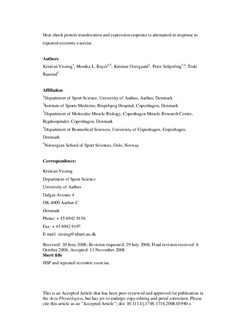| dc.contributor.author | Vissing, Kristian | |
| dc.contributor.author | Bayer, Monica | |
| dc.contributor.author | Overgaard, Kristian | |
| dc.contributor.author | Schjerling, Peter | |
| dc.contributor.author | Raastad, Truls | |
| dc.date.accessioned | 2009-11-17T13:40:24Z | |
| dc.date.issued | 2008-11-20 | |
| dc.identifier | Seksjon for fysisk prestasjonsevne / Department of Physical Performance | |
| dc.identifier.citation | Acta Physiologica. 2009, 196(3), 283-293 | en |
| dc.identifier.issn | 1748-1708 | |
| dc.identifier.uri | http://hdl.handle.net/11250/170495 | |
| dc.description | I Brage finner du siste tekst-versjon av artikkelen, og den kan inneholde ubetydelige forskjeller fra forlagets pdf-versjon. Forlagets pdf-versjon finner du på http://www3.interscience.wiley.com/journal/121528450/abstract / In Brage you'll find the final text version of the article, and it may contain insignificant differences from the journal's pdf version. The definitive version is available at http://www3.interscience.wiley.com/journal/121528450/abstract | en |
| dc.description.abstract | Aim: This study hypothesized that heat shock protein (HSP) translocation and upregulation is more probable to occur after eccentric exercise than after concentric exercise or repeated eccentric exercise. Methods: Fourteen young, healthy, untrained male subjects completed two bench-stepping exercise bouts with 8 weeks between bouts, and were compared with a control group (n = 6). Muscle biopsies collected from m. vastus lateralis of both legs prior to and at 3 h, 24 h and 7 days after exercise were quantified for mRNA levels and/or for HSP27, αβ-crysllin and inducible HSP70 content in cytosolic and cytoskeletal protein fractions. Results: The first bout of exercise reduced muscle strength and increased muscle soreness predominantly in the eccentric leg (P < 0.05). These responses were attenuated after the repeated eccentric exercise bout (P < 0.05), suggesting a repeated bout adaptation. Increases in inducible HSP70 and HSP27 protein content in cytoskeletal fractions were observed exclusively after eccentric exercise (P < 0.05). For HSP27, an approx. 10-fold upregulation after first-bout eccentric exercise was attenuated to a an approximately fourfold upregulation after the repeated eccentric exercise bout. mRNA levels for HSP70, HSP27 and αβ-crystallin were upregulated within approximately two to fofold ranges at time points 3 and 24 h post-exercise (P < 0.05). This upregulation was induced exclusively by eccentric exercise but with a tendency to attenuated expression 3 h after the repeated eccentric exercise bout. Conclusion: Our results show that HSP translocation and expression responses are induced by muscle damaging exercise, and suggest that such HSP responses are closely related to the extent of muscle damage. | en |
| dc.format.extent | 199157 bytes | |
| dc.format.mimetype | application/pdf | |
| dc.language.iso | eng | en |
| dc.publisher | Wiley | en |
| dc.subject | gene and protection expression | en |
| dc.subject | protein degradation | en |
| dc.subject | protein translocation | en |
| dc.subject | repeated bout effect | en |
| dc.subject | transcriptional regulation | en |
| dc.title | Heat shock protein translocation and expression response is attenuated in response to repeated eccentric exercise | en |
| dc.type | Peer reviewed | en |
| dc.type | Journal article | en |
| dc.subject.nsi | VDP::Mathematics and natural science: 400::Basic biosciences: 470 | en |
| dc.subject.nsi | VDP::Medical disciplines: 700::Basic medical, dental and veterinary science disciplines: 710 | en |
| dc.source.pagenumber | 283-293 | en |
| dc.source.volume | 196 | en |
| dc.source.journal | Acta Physiologica | en |
| dc.source.issue | 3 | en |
